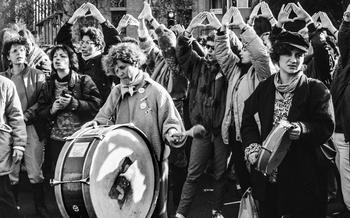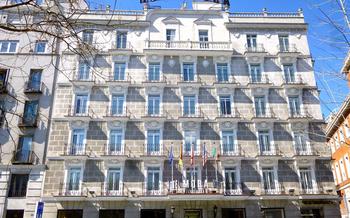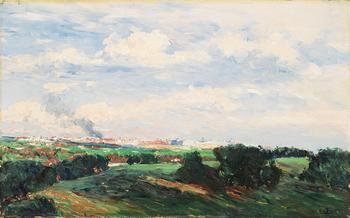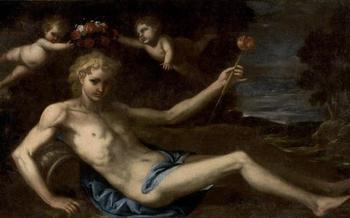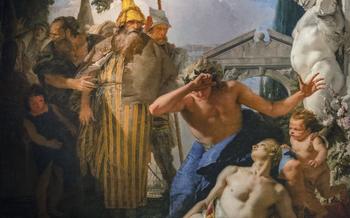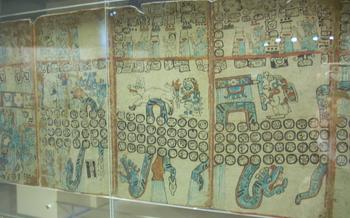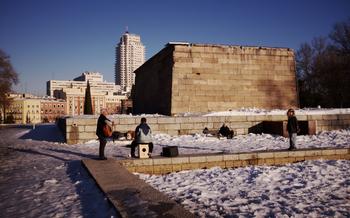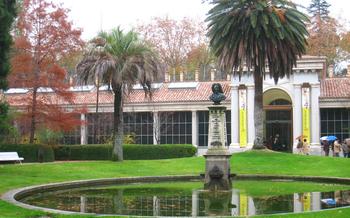
Museum of the Americas
- Delving into the Museum of the Americas: A Journey Through the Cultural Legacy of the Americas
- Location and Transportation
- Hours of Operation:
- Admission Fees:
- Exhibition Highlights
- Guided Tours
- Educational Programs
- Museum Shop
- Accessibility
- Photography and Videography
- Food and Beverages
- Museum Etiquette: Respecting the Art and Others
- Nearby Attractions:
- Safety and Security:
- Insider Tip: Unveiling Hidden Gems
Delving into the Museum of the Americas: A Journey Through the Cultural Legacy of the Americas
The Museum of the Americas in Madrid stands as a testament to the vibrant cultural heritage of the Americas, spanning from the ancient civilizations of Mesoamerica and the Andes to the diverse indigenous communities of North America. Founded in 1941, the museum's mission is to preserve, study, and showcase the rich artistic, historical, and ethnographic treasures of the Americas, offering visitors a profound insight into the region's diverse cultures and traditions.
Through its extensive collection of over 20,000 artifacts, the museum provides a comprehensive overview of pre-Columbian and colonial America. Visitors can marvel at intricate gold ornaments, finely crafted pottery, monumental stone sculptures, and colorful textiles, each representing a unique chapter in the history of the Americas. The museum's galleries are organized thematically and chronologically, allowing visitors to trace the development of ancient civilizations, their interactions with the natural world, and their enduring legacies.
The Museum of the Americas is not merely a repository of artifacts; it is a dynamic center for research, education, and cultural exchange. The museum's team of experts conducts ongoing research on the indigenous cultures of the Americas, contributing to a deeper understanding of their traditions, beliefs, and artistic expressions. The museum also organizes educational programs, workshops, and lectures, fostering a dialogue between scholars, artists, and the general public.
Location and Transportation
The Museum of the Americas is conveniently located at Calle de Alcalá, 62, 28012 Madrid, Spain. It is situated in the heart of the city, near the Recoletos and Banco de España metro stations. Visitors can take advantage of the extensive metro network to reach the museum from any part of Madrid. Alternatively, buses and taxis are readily available for those who prefer surface transportation.
Hours of Operation:
The Museum of the Americas in Madrid, Spain, welcomes visitors with a well-defined schedule to ensure an enjoyable and convenient experience.
-
Regular Hours: The museum's regular hours of operation are Tuesday through Sunday, from 10:00 AM to 6:00 PM. This allows ample time to explore the diverse exhibits and engage with the rich cultural heritage of the Americas.
-
Seasonal Variations: During the summer months, from July 1st to September 30th, the museum extends its hours of operation, remaining open until 8:00 PM on weekdays (Tuesday through Friday). This extended schedule provides more flexibility for visitors to beat the heat and enjoy a leisurely visit during the longer daylight hours.
-
Special Openings and Closures: The Museum of the Americas occasionally offers special openings or extended hours during festivals or cultural events. These special openings are announced in advance on the museum's website and social media channels, so visitors are encouraged to stay informed. The museum remains closed on Mondays, as well as on specific national holidays, such as Christmas Day and New Year's Day.
-
Online Updates: For the most up-to-date information on the museum's hours of operation and any special events, visitors are recommended to check the museum's official website. This ensures that they can plan their visit accordingly and make the most of their time at the Museum of the Americas.
Admission Fees:
The Museum of the Americas offers a range of admission fees to cater to different visitors. The general admission fee for adults is [price]. Students, seniors, and groups can avail discounted rates, with specific prices varying. Moreover, the museum offers free admission on certain days, such as the first Sunday of every month. For up-to-date information on admission fees and free admission days, please refer to the museum's official website. Additionally, consider purchasing tickets online in advance to avoid queues, especially during peak tourist season. This convenient option allows you to secure your entry and make the most of your visit to this captivating museum.
Exhibition Highlights
The Museum of the Americas houses a captivating array of exhibits that transport visitors to the vibrant cultures of the Americas. The collection boasts over 12,000 artifacts, each narrating a unique story of the region's rich history. Among the must-see exhibits is the "Gold of the Incas" collection, showcasing intricate gold ornaments and jewelry that once adorned royal Incan figures. The "Aztec Calendar Stone" is another highlight, symbolizing the sun and representing the sophisticated astronomical knowledge of the Aztec civilization.
The museum also houses a remarkable collection of textiles from various indigenous cultures. These vibrant fabrics, adorned with intricate patterns and colors, showcase the artistic prowess and craftsmanship of skilled weavers. Visitors can admire the "Paracas Mantle", an iconic textile from Peru, which features a stunning depiction of a mythical creature.
For those interested in religious art, the museum's "Colonial Art" collection is a must-see. This collection showcases religious paintings, sculptures, and other artworks that reflect the fusion of European and indigenous artistic traditions. The "Virgin of Guadalupe" painting, a symbol of Mexican Catholicism, is a particularly significant piece in this collection.
To further enhance the visitor experience, the museum offers interactive displays and multimedia presentations. These interactive exhibits bring the artifacts to life, providing insights into the lives and customs of the indigenous peoples. Visitors can learn about traditional dances, music, and rituals through these engaging displays.
Through these captivating exhibits, the Museum of the Americas offers an immersive journey into the diverse cultural heritage of the Americas, leaving visitors with a profound appreciation for the region's rich history and traditions.
Guided Tours
Enhance your visit to the Museum of the Americas by joining a guided tour. Led by experienced and knowledgeable guides, these tours offer a deeper dive into the museum's collection and its cultural significance. Delve into the stories behind the artifacts and gain insights into the diverse indigenous civilizations of the Americas.
General Overviews: Opt for a comprehensive overview tour to get a broad understanding of the museum's highlights. These tours cover the major exhibits and provide historical context and cultural insights.
Thematic Tours: If you have specific interests, choose a thematic tour that focuses on a particular aspect of the collection. These tours explore topics such as ancient civilizations, textiles, ceramics, or religious practices.
Specialized Tours: For a more in-depth experience, consider booking a specialized tour tailored to your interests. These tours can be organized for individuals or small groups and cover specific themes or artifacts.
Guided tours are available at regular intervals throughout the day. Advance booking is recommended to secure your spot, especially during peak tourist season. Check the museum's website or inquire at the information desk for tour schedules and availability.
Educational Programs
The Museum of the Americas goes beyond showcasing artifacts by providing a comprehensive range of educational programs that cater to diverse audiences. Designed to promote cultural awareness, engagement, and learning, these initiatives encompass workshops, lectures, interactive activities for children, and educational resources for schools.
Workshops and Lectures: The museum regularly hosts workshops and lectures led by experts in the fields of anthropology, history, and art. These sessions delve deeper into specific topics related to the indigenous cultures of the Americas, offering attendees the opportunity to gain specialized knowledge and insights.
School Group Visits: To facilitate educational experiences for students of all ages, the museum offers guided tours tailored to school groups. These tours are designed to complement classroom curricula, bringing history and culture to life through interactive learning and hands-on activities. Teachers can choose from a variety of themes and age-appropriate content to create a customized visit that meets the specific needs and interests of their students.
Outreach Programs: The museum extends its educational reach beyond its walls through outreach programs that engage communities and promote cultural awareness. These programs include traveling exhibitions, educational kits for schools, and community-based workshops. By bringing the museum's resources and expertise to diverse audiences, the outreach initiatives foster a broader understanding of the rich cultural heritage of the Americas.
Museum Shop
The Museum of the Americas features a well-curated museum shop that offers a diverse selection of souvenirs, books, and replicas. Here, visitors can find unique and authentic mementos of their visit, including high-quality replicas of indigenous artworks and artifacts. These replicas are meticulously crafted to preserve the intricate details and symbolism of the original pieces, providing an opportunity to own a piece of history.
The proceeds from the museum shop directly support the museum's conservation and research efforts, ensuring the preservation of cultural heritage and the continuation of educational initiatives. Visitors are encouraged to browse the shop and discover a variety of gifts, educational materials, and souvenirs that celebrate the rich cultural legacy of the Americas. Whether it's a replica of an ancient Maya sculpture, a traditional textile, or a book on indigenous history, the museum shop offers something for every visitor to cherish and remember their experience.
Accessibility
The Museum of the Americas is committed to providing an inclusive and accessible environment for all visitors. Wheelchair ramps, elevators, and accessible restrooms are available throughout the museum to ensure that everyone can enjoy the exhibits comfortably. Assistive devices such as audio guides and sign language interpreters can be arranged upon request to enhance the experience for visitors with disabilities. The museum staff is dedicated to accommodating the needs of all visitors and encourages anyone with specific requirements to contact them in advance to discuss accommodations.
Photography and Videography
The Museum of the Americas respects the intellectual property rights of its artists and artifacts. While photography and videography are generally permitted for personal, non-commercial use, visitors must adhere to the following guidelines:
-
Respect for the Artwork: Photography and videography must not interfere with the enjoyment of other visitors or damage the artworks. Please maintain a respectful distance from the exhibits and use flash photography only when permitted.
-
Permissions: If you wish to use images or footage for commercial purposes, such as publication or broadcast, you must obtain prior written permission from the Museum of the Americas. Please contact the museum's administration for more information and assistance.
-
Protect Privacy: Visitors should be mindful of other people's privacy when taking photographs or videos. Avoid capturing individuals without their consent, especially in sensitive areas such as restrooms or nursing rooms.
-
Social Sharing: We encourage visitors to share their experiences at the Museum of the Americas on social media. Tag us using @MuseumOfTheAmericas and use the hashtag #MuseumOfTheAmericas to connect with other visitors and share your discoveries with the world.
Please remember that the museum's collection is a precious cultural heritage, and we appreciate your cooperation in preserving it for future generations.
Food and Beverages
The Museum of the Americas offers a cafeteria, "El Refectorio," where visitors can take a break and enjoy a variety of culinary delights. The menu features a selection of local Spanish dishes, as well as international cuisine to cater to diverse tastes. Visitors can indulge in traditional Spanish tapas, savor the flavors of a hearty paella, or opt for a refreshing salad or sandwich. For those seeking a quick snack, vending machines and snack bars are conveniently located throughout the museum, providing a range of beverages and light refreshments. Visitors are also welcome to bring their own water bottles or snacks if they prefer, allowing them to stay hydrated and energized throughout their visit.
Museum Etiquette: Respecting the Art and Others
The Museum of the Americas encourages a respectful and considerate environment for all visitors. To ensure a pleasant experience for everyone, it is important to follow proper museum etiquette.
Be Mindful of Noise: Maintain a quiet and respectful atmosphere in the galleries. Avoid loud conversations or disruptive noises that may disturb others' enjoyment of the exhibits.
Handle with Care: Refrain from touching or handling the artworks and artifacts. These precious objects are irreplaceable and should be preserved for future generations.
Patience and Courtesy: When viewing popular exhibits, be patient and take turns to allow everyone a chance to appreciate them. Avoid blocking others' views or monopolizing the space.
Photography Etiquette: Follow the museum's photography policies. If photography is permitted, be mindful of the use of flash and tripods, which may be prohibited in certain areas.
By observing these guidelines, visitors can contribute to a positive and enriching experience for themselves and others, ensuring that everyone can fully appreciate the museum's treasures.
Nearby Attractions:
A visit to the Museum of the Americas can be seamlessly combined with a broader exploration of Madrid's cultural treasures. A short stroll away lies the renowned Prado Museum, a haven for art enthusiasts, showcasing masterpieces by Spanish masters like Goya, El Greco, and Velázquez. For a tranquil escape, the nearby Retiro Park beckons with its sprawling gardens, serene lake, and iconic Crystal Palace.
Just a metro stop away, immerse yourself in the vibrant atmosphere of the Rastro flea market, a treasure trove of antiques, vintage clothing, and local crafts. The neighboring Reina Sofia Museum offers a compelling journey through modern and contemporary Spanish art, featuring iconic works by Picasso, Dalí, and Miró.
Enrich your cultural experience further with a visit to the nearby San Francisco el Grande Basilica, a stunning example of Neoclassical architecture, or the Egyptian Temple of Debod, an ancient Egyptian temple relocated to Madrid, offering panoramic city views.
By venturing beyond the museum's walls, you'll discover a vibrant tapestry of history, art, and culture, making your Madrid experience truly unforgettable.
Safety and Security:
Your safety and security are our top priorities at the Museum of the Americas. Our dedicated security team maintains a vigilant presence throughout the premises, ensuring a secure environment for visitors and staff alike. We employ state-of-the-art surveillance systems and regular patrols to deter and prevent any untoward incidents. Our staff is trained to respond promptly and effectively to any situation that may arise.
To contribute to a safe and enjoyable experience for everyone, we kindly request visitors to remain vigilant and report any suspicious activity to our staff immediately. Please take general safety precautions, such as keeping your valuables secure and being aware of your surroundings. By working together, we can create a safe and welcoming environment for all to appreciate the cultural treasures of the Americas.
Insider Tip: Unveiling Hidden Gems
As you wander through the museum's galleries, keep an eye out for a hidden gem known as the "Codex Borgia." This ancient manuscript, dating back to the 16th century, is a masterpiece of Mesoamerican art. Its vibrant illustrations and intricate symbols offer a glimpse into the beliefs and rituals of the pre-Columbian Mixtec civilization. While it may not be as well-known as some of the other exhibits, the Codex Borgia is a treasure trove of cultural and historical significance.
To fully appreciate its beauty and complexity, consider visiting the museum during a quieter time, such as a weekday morning. This will allow you toじっくりと,じっくりとobserve the details of the manuscript without the distractions of large crowds. Don't hesitate to ask the museum staff about the Codex Borgia or any other exhibits that pique your curiosity. They are a wealth of knowledge and can provide fascinating insights into the museum's collection.
